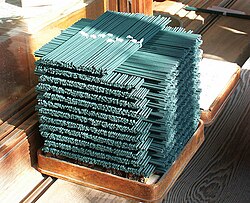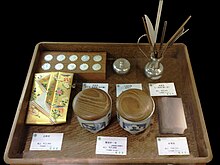Incense in Japan
This article includes a list of generalreferences,butit lacks sufficient correspondinginline citations.(March 2017) |

The burning ofincense in Japanbegan during the 6th century (theAsuka period) with the introduction ofBuddhism,which uses incense during rituals and ceremonies.Agarwoodwas imported into Japan from China via Korea. From that point on,incensewould become an important facet ofJapanese culture.Incense is used for a variety of purposes, including Buddhist ceremonies, spirituality and meditation.
There are two major types of incense in Japan, which are either heating or smouldering small pieces of fragrant wood, or direct-burning incense in form of sticks or cones formed out of paste without a bamboo stick.
Many of the current incense companies have been in existence for more than 300 years.
Etymology[edit]
The word incense (kō) in Japan is written in the ChineseKangxiradical 186composed of nine strokes, hương, which can also be expanded up to 27 strokes hinh. A literal translation is "fragrance", though in context it is understood as "incense". The word nóidōmay be added, which means "way", both literally (street) and metaphorically (a stream of life experience), to givekōdō:the "way of incense", which involves using incense within a structure of codified conduct.
History[edit]

Nihon Shoki,a book of classical Japanese history, gives the first formal record of incense in Japan when a log ofagarwood,a fragrant wood used in incense burning, drifted ashore onAwaji Islandduring theAsuka periodin 595 CE, and was presented toPrince Shōtokuand theEmpress Suiko.[1]Shōtoku knew of incense burning fromBuddhism,which had been introduced into Japan around 538 CE; incense was part of Buddhist ritual,[2]and was imported into Japan from China through Korea.[3]Agarwood was imported in 538 CE during the building of a temple. A ritual known assonaekōbecame established.Kobokufragrant wood combined with herbs and other aromatic substances was burned to provide a fragrant incense for religious purposes.[4]The custom of burning incense was further developed and blossomed amongst the court nobility with the pastime oftakimono,a powdered mixture of aromatic substances.[5]Fragrant scents played a vital role at court life during theHeian period,robes and even fans were perfumed and poems written about them, it also featured prominently in the epicThe Tale of Genjiin the 11th century.
Samurai warriors would prepare for battle by purifying their minds and bodies with the incense ofkoboku;developing an appreciation for its fragrances. In the lateMuromachi periodin the 16th century, this aesthetic awareness would develop into the accomplishment known as kōdō, which is the art of enjoying the incense of smoulderingkoboku.[6]The present style of kōdō has largely retained the structure and manner of the Muromachi period, in which time thetea ceremonyand theikebanastyle of flower arrangement developed as well.
During theTenshō erain the late 16th century, the master craftsmen Kōju was employed at theKyoto Imperial Palaceand practiced incense ceremony. The third Kōju served underToyotomi Hideyoshi,the fourth underTokugawa Ieyasu.The eighth Kōju Takae Jyuemon was known as a particular master of incense of note. During this time the “Ten Virtues of Kō” ( hương の mười đức,kōnojūtoku) were formulated, which is a traditional listing of the benefits derived from the proper and correct use of quality incense:[7][8][9]
- Cảm cách quỷ thần: Sharpens the senses
- Thanh tịnh tâm thân: Purifies the body and the spirit
- Có thể 払 ô uế: Eliminates pollutants
- Có thể 覚 giấc ngủ: Awakens the spirit
- Tĩnh trung thành hữu: Heals loneliness
- Trần du nhàn: Calms in turbulent times
- Nhiều mà không nề: Is not unpleasant, even in abundance
- Mộ mà thấy đủ: Even in small amounts is sufficient
- Lâu tàng bất hủ: Does not break down after a very long time
- Thường dùng vô chướng: A common use is not harmful
Even today, there is a strong relationship and holistic approach in kōdō between fragrant scent, the senses, the human spirit, and nature. The spirituality and refined concentration that is central to kōdō places it on the same level as kadō and chadō.
The start of theEdo periodin the 19th century saw major changes in the history and production of incense. Senkō incense sticks became more widely available to the general public as production method shifted to an industrial scale. At the start of the 20th century, mainichi-kō, or "everyday incense" was developed by the master craftsman Kitō Yujiro during the Meiji andTaishō era.
Today companies such asNippon Kodo,Shoyeido,andBaieidoare some of the most established suppliers for incense.
Material[edit]
The fragrant woodsagarwoodandsandalwoodare the main ingredients used in Japanese incense. Agarwood is produced in certain parts of southeast Asia such as Vietnam. Japanese incense companies divide agarwood into six categories depending on the region obtained and properties of the agarwood.[10]The trees secrete an aromatic resin, which over time turns into kōboku. One particular grade of kōboku with a high oil content and superior fragrance is called kyara. Kyara is currently worth more than its weight in gold. Sandalwood originates primarily from India, Indonesia, southern China or other parts of southeast Asia. Sandalwood trees need around 60 years to produce their signature fragrance that can be deemed acceptable to be used for kōdo. The most valued sandalwood comes fromMysorein the state ofKarnatakain India, where it is endangered. Makkō (which translates as "incense powder" ) is used to bind the ingredients together. It is able to bind ingredients while having little scent of its own.
Other materials used arecinnamon bark,chebulic myrobalan,clove,ginger lily,lavender,licorice,patchouli,spikenard,camomile,rhubarb,safflower,star anise,and otherherbs.Shellfragrances and other animal-derived aromatic materials are also used.

Raw materials such as agarwood are becoming increasingly rare due to the depletion of the wild resource. This has made prime material very expensive. For example, the cost of lower gradekyarais about 20,000 yen per gram. Top qualitykyaracosts over 40,000 yen per gram, or many times the equivalent weight of gold (as of late 2012). If the particular piece of incense wood has a history, the price can be even higher. The highest regarded wood, ranjyatai, dates back to at least the 10th century and iskyarawood from Laos or Vietnam, and was used by emperors and warlords for its fragrance. It is said to contain so much resin that it can be used many times over. The wood is kept at theShōsōintreasury in Nara, which is under the administration of the Imperial Household. The high costs and difficulty in obtaining acceptable raw material is one of the reasons why kōdō is not as widely practised or known compared to the art of flower arrangement or the tea ceremony.
Types of incense[edit]
Sasaki Dōyō(1306–1373), who was regarded as a paragon of elegance and luxury and the quintessential military aristocrat duringNanboku-chō period,owned many incense woods and named them.
ShōgunAshikaga Yoshimasa(1436–1490) himself appreciated precious scented woods and collected some or inherited them from Sasaki. In order to properly organise the large collection of incense wood, he appointed the experts of that time Sanjonishi Sanetaka, who became the founder of the Oie School, and Shino Soshin, the founder of the Shino School. They established a classifying system calledrikkoku gomi,which means "six countries, five scents".
| Name | Character | rikkoku(country) | gomi(scent) |
|---|---|---|---|
| kyara | Già la | Vietnam | bitter |
| rakoku | La quốc | Thailand | sweet |
| manaka | Thật kia già | Malacca,Malaysia | no scent |
| manaban | Thật Nam Man | unknown | salty |
| sasora | Tá từng la | India | hot |
| sumotara / sumontara | Tấc nghe nhiều la | Sumatra,Indonesia | sour |
*Manabancomes from the wordnanbanwhich means "southern barbarian", and was brought to Japan by Portuguese traders with unknown origin.[11]
Incense makers[edit]
One of the oldest traditional incense companies in Japan isBaieido,founded in 1657 with roots going back to the Muromachi period. Ostensibly the longest standing incense maker is Kungyokudo, established in the third year of theBunrokuera (1594), and originally operating as an apothecary serving theNishi HonganjiBuddhist Temple in Kyoto.[12]Other traditional and still operating companies include Kyukyodo (1663, Kyoto), andShoyeido,founded in 1705 in Kyoto.Nippon Kodois also a major supplier of incense material.
Both Baieido and Shoyeido are used extensively by Zen Buddhist temples, both in Japan and worldwide.Nippon Kōdōwas established by incorporation in New York City in August 1965 and is the largest seller of Japanese incense worldwide. Most of their incense is "everyday" quality ( mỗi ngày mainichi). They do make some "traditional" incense as well. These three are the major exporters of Japanese incense.
Currently, 70% of all of Japan's incense is manufactured on a small island south of Osaka called Awaji Island. The history extends back to 1850 in Ei of the city of Awaji in 1850 when Senshuu Sakai manufacturing technology was introduced. At the time, Ei was a military run trade port for the Tokushima Clan, which opened the door to the import and sale of raw materials used in making incense. Over time, the incense made in Awaji Island became renowned throughout Japan. The main reason incense manufacturing took root in Awaji Island is because of its nishi-kaze (west wind). This strong seasonal wind hampers the fishing industry, giving rise to the necessity for cottage industries such as incense making. This wind is also great for drying incense.[13]
Kyūkyodō, Kunmeidō, and Kōkandō also sell some incense overseas. It may be difficult to find the other brands outside Japan. There are numerous other incense makers in Japan, of course. These are the either the major sellers or the oldest companies in Japan.
Kōdō[edit]

Kōdō(Hương nói,Way of Incense)is theJapanese artof appreciating incense, similar to thetea ceremony,in which participants follow established practises involving the preparation and enjoyment of incense.[14]Though it is counted as one of the three classical arts of refinement, it is relatively unknown amongst modern Japanese people.[citation needed]Kōdō includes all aspects of the incense process – from the tools (kōdōgu(Hương đạo cụ)), which, much like tools of the tea ceremony, are valued as high art, to activities such the incense-comparing games kumikō and genjikō.
For kumikō, participants sit near one another and take turns smelling incense from acenseras they pass it around the group. Participants comment on and make observations about the incense, and play games to guess the incense material. Genjikō is one such game, in which participants are to determine which of five prepared censers contain different scents, and which contain the same scent. Players' determinations (and the actual answers) are recorded usinggenji-monlinear patterns, the elements of which allude to chapters in theTale of Genji.[15]
Apart from kōdō, incense can also be used during the tea ceremony or other functions. A variety of containers and censers, orkōro,made out of porcelain, wood, lacquer or other materials were created over the centuries for this purpose, such askōgō,andkōbako,all of which can be supremely valuable items.[16]
See also[edit]
References[edit]
- ^Kiyoko Morita (30 Oct 2006).The Book of Incense: Enjoying the Traditional Art of Japanese Scents.Kodansha International. p. 31.ISBN9784770030504.
- ^Silvio A. Bedini (24 Mar 1994).The Trail of Time: Time Measurement with Incense in East Asia.Cambridge University Press. p. 159.ISBN9780521374828.
- ^Kiyoko Morita (30 Oct 2006).The Book of Incense: Enjoying the Traditional Art of Japanese Scents.Kodansha International. p. 32-33.ISBN9784770030504.
- ^"Buddhist Incense-Sonae-ko".naturalscents.net.2 November 2021.
- ^"In Ghostly Japan".sacred-texts.Retrieved12 April2017.
- ^Bincsik, Author: Monika."Japanese Incense – Essay – Heilbrunn Timeline of Art History – The Metropolitan Museum of Art".metmuseum.org.Retrieved12 April2017.
{{cite web}}:|first=has generic name (help) - ^"The Ten Virtues of Koh".Naturalscents. 8 November 2021.
- ^"Virtues of Koh".Komori-Corp.
- ^"Incense Around The World".Vienna Imports. 2 February 2018.
- ^"The Rikkoku – Traditional Japanese Classifications of Aloeswood used for Kodo".Making-Incense.Retrieved2008-01-31.
- ^"Aloeswood".naturalscents.net. 3 November 2021.
- ^"KUNGYOKUDO".KUNGYOKUDO.Retrieved2023-09-29.
- ^"Scent of Awaji".gov-online.go.jp.
- ^Jessica Sayuri Boissy (31 March 2016)."Kodo: the Way of Incense".gaijinpot.
- ^Japan Encyclopedia,p. 237, atGoogle Books
- ^Asahi Shinbusha (1978).Exhibition of Kôgô: Japanese Ceramic Incense Boxes from the George Clemenceau Collection.The Montreal Museum of Fine Arts.
Further reading[edit]
- Kōdō nyūmon(Introduction toThe Way of Incense). Kyoto: Tankosha, 1998.
- Morita, Kiyoko.The Book of Incense.Tokyo: Kodansha International, 1992.
